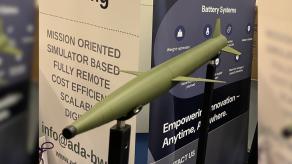After russia withdrew from the Black Sea Grain Initiative and threatened to destroy any vessel heading towards Ukraine, effectively declaring unlimited maritime war, several ships have already entered Ukrainian ports.
So, the Kremlin's cries have indeed attracted attention, but the declared total maritime blockade has not been implemented. This does not negate the fact that the enemy systematically carries out strikes on Ukraine's port infrastructure, destroying grain elevators where the grain is stored.
Read more: In Addition to Large Landing Ship Near Novorossiysk, Ukrainians Also Hit a russian Facility in Feodosia in Crimea (Video)
However, against this backdrop, russia has the capability to resort to traditional deceptive tactics, as explained by military expert Petro Chernyk for ArmyInform. According to him, the russian Black Sea Fleet may conduct underwater mining.

As Defense Express estimates, russia currently has about five Project 636 "Varshavyanka" submarines in the Black Sea, which are capable of performing this task. The fact is that placing mine barriers for a submarine is a relatively traditional task.
Unlike a direct torpedo attack, in the conditions of the Black Sea and the task of disrupting virtually coastal navigation, this is a more realistic scenario.
For this purpose, russian submarines have several types of sea mines designed for standard 533 mm torpedo tubes. These include MSM, MDS-1 (SMDM-1), and MDM (UDM) mines, which, according to official information, are in service with the russian Navy.
MDS-1 (an updated version of SMDM-1) is a self-propelled mine, which can be placed without directly approaching the desired mining area, as it has a range of 17 km. It was adopted into service in 1979, indicating the availability of these mines. Considering this, russia could well attempt to deploy such mines without entering territorial waters.

After launching, the mine travels along a programmed route, settles on the seabed, assumes combat position, and activates its acoustic, electromagnetic, and hydrodynamic sensors. In this state, the mine can stay for a year, after which the self-destruct mechanism activates.
When a ship appears within 40 meters, the explosive charge weighing 300 kg detonates. The minimum placement depth is 6 meters, and the maximum is up to 120 meters. Its purpose is to combat not only surface but also underwater vessels.
Meanwhile, depths in the western part of the Black Sea range from 20 to 45 meters, which means the combat part of the MDS-1 mine, which lies on the bottom of the sea, is sufficient to destroy civilian vessels.
Another similar MSM mine - a sea shelf mine, is anchor-type and has a maximum depth of placement of up to 300 meters, with the anchor located at a depth of up to 600 meters. To lay it a submarine must be located directly within the minefield creation zone. Laying it requires a submarine to be directly in the minefield creation area.

The targeting principle is similar to that of MDS-1, except that this mine has a rocket engine for underwater propulsion, allowing it to attack surface ships or submarines even from considerable depths.
Moreover, in this context, MDM (UDM) is the simplest bottom mine, which is not self-propelled, does not have a propulsion engine, but is equipped with a combat unit weighing 645-800 kg. These mines also have three-channel sensors and are supposed to be laid at a shallow depth when countering surface targets.

It should also be noted that russia has been working on improving these mines. However, according to assessments from the relevant russian community, they have fallen behind from foreign models by decades. Nevertheless, some new versions, which serial production is under the question, were integrated with such feature as mine activation only on a specific type of ship and the ability to skip a certain number of targets, etc. However, in the case of the Kremlin attempting to create a maritime blockade using mines from submarines, this would be of no significance.
It is also important to consider that the Armed Forces of Ukraine are lack of the means to combat enemy submarines and effectively counter mines at a significant distance from the coastline.
Thus, the task of navigation safeguarding in the Black Sea (particularly its western and southern parts that are effectively waters of the Alliance), should fall upon the NATO Allied Forces.
However, it is hard to imagine a situation in which, for instance, an aircraft of such type as the P-8A Poseidon equipped with sensors that are capable for detecting not only submarines but also the attempts to lay underwater mine barriers, can destroy a russian submarine.
As Defense Express reported, Ukrainian Military Destroyed the Newest Buk-M3 SAM System, 9С18М3 Target Detection Radar. We also wrote, that Ukrainian Air Assault Troops Showed How They Destroy Enemy With Attack UAVs.
Read more: Spectacular Video of the russian Olenegorsky Gornyak Landing Ship Defeat by Ukraine’s Kamikaze Boat Appeared














